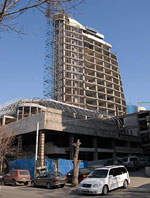After the end of the economic crisis the authorities of our countries entered a period, which may be called state fortunetelling. Everybody suddenly realized that the dual-digit numbers that have been imposed for years were just a balloon and is vulnerable because it is not built on industrial and exportable branch and is built on construction.
And suddenly all those people, who during the previous years, were actively participating in inflating the balloon or were applauding from the side, have started to announce in pathos that it was necessary to diversify the economy. Indeed, in parallel with this they were speaking about the next shortcoming of the economy – about its oligopoly structure. And as usual the thing didn’t move anywhere else but conversations. However, if in the process of fighting oligopolies the “tongue” of the government is short then the situation is a little different regarding the structure of the economy. The global crisis and almost the double-slump of the construction volume as a result of that created a situation when the ratio of construction drastically decreased in the GDP. It means that the structure of the economy has changed not at the expense of the development of other branches of economy but due to the slump of construction. Indeed our officials couldn’t possibly miss the occasion of finding positive elements in this fiasco. They were doing so up until recently when the National Statistics Service publicized the results of January-April of the current year. And these numbers were speaking of the fact that the main culprit of the balloon the construction sector is evolving now and has already registered growth in the amount of 8.8% compared to the previous year. It was necessary to find explanation to this. And so the government did. We have already spoken about the statements of the head of the NA Standing Committee on Finance and Budget Gagik Minasyan, who claimed that the base of the previous year, based on which the index of the current year was calculated, had drastically reduced in April and the growth of the construction indexes were stipulated by this reason. Let us assume it is so (but we’d like to remind of the reason, to which we will advert). In that case it turns out that the growth of the construction sector occurs regardless of the governmental policy then in the same manner the whole GDP growth has a technical character.
Nevertheless, in a surprising coincidence, on the next day of Minasyan’s statement the NSS publicized the detailed indices of January-April and it became clear that the government has quite well stimulated the growth of the construction sector. The table presented below, which we have prepared based on the data of the NSS of the current and previous years, is the best evidence of that. As you see in January-April of the current year construction in the amount of 66.5 billion AMD was conducted, which exceeds the index of the crisis year by 8.8% but it yields the pre-crisis year (2008) index, which was 71.1 billion AMD. But the most noteworthy thing was to understand at the expense of which this number was formed. Thus, 19.2 billion (28.9%) out of that was realized at the expense of the means of the population and 39.9 billion AMD (56.2%) was accumulated at the expense of the organizations. It means that the major part of the construction sector – 85.1%, was attained due to the expenses of the private sector. The rest of the tiny share was of the state (7.5%), international loans and humanitarian aid. Now let’s review the indices of January-April of the current year. The ratio of construction grew twice at the expense of the state budget by reaching 15.5%. During the first 4 months of 2008, when they were not speaking of the construction yet and they were not agreeing that the big level of construction may be harmful, construction worth 5.3 billion was conducted at the expense of the state budget. Then they started to speak about the necessity of diversification of the economy and the need of diminishing the ratio of the construction. However, it turns out that on parallel with speaking during the past 2 years they have spent twice as much on economy than during the pre-crisis year, which amounted to 10 billion AMD. Moreover, if we take into account the fact that the state has more control of the international grants (from the World Bank and other structures) then the support demonstrated to construction becomes more evident. Thus during the first 4 months of the pre-crisis year the consecution at the expense of international funds amounted to a little more than 1 billion AMD, during the crisis year the construction amounted to 2.5 billion AMD and during the first 4 months of the current year the support amounted to 23.0 billion AMD. The most interesting thing is that the World Bank that is criticizing the construction balloon of our state has provided 7.6 billion AMD for the construction, which is several times more than in the previous years. Let us mention another important nuance. As the table shows, during the first 4 months of the crisis year at the expense of the means of organizations and people the volumes of construction have been much larger than in the previous years. It means that in the line of private constructors (who, by the way, 2 years ago were providing 85% of construction) the base indices have been much higher. This means that if the government hadn’t directed unprecedented means to the construction sector we would have had 8.8% slump instead of 8.8% growth. Let us add that the problem is not whether the government did the right or the wrong thing. It is simply not so necessary to do everything for the sector and then speak of diversification and raise the numbers by technical reasons. Finally, not only the government members understand simple math.

